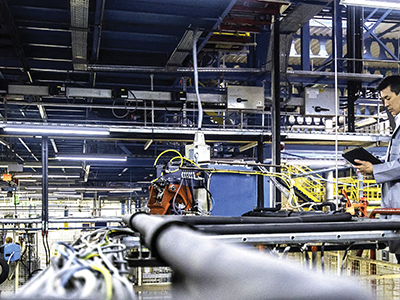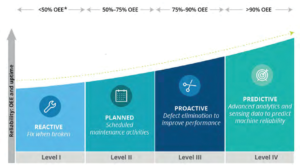
Artificial Intelligence: AI trained by vibration science promises to revolutionize maintenance practices
Mike Edwards
Features AI artificial intelligence maintenance AI trained by vibration
science promises to
revolutionize maintenance practices.
AI trained by vibration
science promises to
revolutionize maintenance practices. The median cost of maintaining a manufacturing facility is $2.60 per gross square foot (ft2). It is only slightly less ($2.36/gross ft2) for office buildings, which makes maintenance even more expensive than the average cost of utilities ($2.10/ft2) in commercial buildings. In fact, typical maintenance costs are as much as double the cost of leasing the space and are a large contributor to the Total Cost of Ownership (TCO) of any equipment.
Thus, maintenance is a time and resource intensive process.
Something is obviously broken
Despite such high costs of maintenance, a 2015 survey of 761 companies by the American Productivity and Quality Center (APQC) showed that the median organization experiences 4% unplanned machine downtime as a percentage of scheduled run time. Further, per a 2016 study by the Aberdeen Group, these unplanned downtime incidents average 4 hours each and cost an average of $260,000 per hour. Additionally, the Information Technology Industry Council (ITI)’s independent survey data indicates that the cost of hourly downtime has risen from 25% to 30% since 2008 when ITI first began tracking these figures.
Unfortunately, due to its excessive reliance on preventative maintenance (PM), the industry, regardless of maintenance spending, continues to experience significant downtime events. The median 4% unplanned downtime in the APQC survey is simply too high. Worse still, IBM reported that a big portion of the money spent on PM is wasted. The negative impacts of these failures are often exponentially more expensive to the organization than the replacement value of failed equipment. In other words, for far too long, too many maintenance dollars have been spent with too few benefits.
This wastage occurs primarily because PM is only effective for age-related failures, which represent a mere 18% of all failures. In its Reliability Centered Maintenance Guide for Facilities and Collateral Equipment, the US National Aeronautics and Space Administration (NASA) says, “Despite the time-honored belief that reliability was directly related to the intervals between scheduled overhauls, searching studies based on actuarial anal.ysis of failure data suggested that the traditional hard-time policies were, apart from their expense, ineffective in controlling failure rates.”
Exclusive use of PM was understandable at a time when actionable ma.chine data was hard to come by. Maintenance teams were naturally forced to rely on a combination of experience, intuition, and original equipment manufacturer (OEM) prescribed service schedules.
The advent of high computational densities that facilitate edge learning, the Internet of Things (IoT), and Artificial Intelligence (AI) have made it possible to eliminate these limitations and are promising to finally re-make maintenance into a predictive and proactive function. For instance, VIE Technologies offers an end-to-end service that combines these new technologies to deliver a highly machine-specific predictive solution that informs the user of future failure events in any type of rotating machinery.
Today’s maintenance problem
Overall equipment effectiveness (OEE) and return on assets (RoA) are two metrics commonly used to compare the performance of disparate operations. OEE measures how well a manufacturing operation is utilized (facilities, time, and material) compared to its full potential during the times when it is scheduled to run. It identifies the percentage of manufacturing time that is truly productive. An OEE of 100% means that only good parts are produced (100% quality) at the maximum speed (100% performance), and without interruption (100% availability). Improving OEE increases revenues due to greater throughput and profitability due to better quality. RoA is a measure of how efficiently a corporation uses its assets to generate earnings. It assesses the return on the capital investments made by a company. The higher the asset utilization in revenue generation the better the RoA. Maintenance organizations exist to improve OEE and RoA.
North American companies average only 40% OEE, which is less than half of what world-class standards consider acceptable. Further, the median RoA for food processing stands at 4.24% in Q1 for 2021, according to CSI Market.
Predictive maintenance adoption
The airline industry was the first to realize the value of predictive and condition-based maintenance. Airlines abandoned scheduled time between overhauls (TBO) in favour of condition-based approaches for the vast majority of their components.

OEE and uptime improve as maintenance practices become less reactive and more predictive. (Click to enlarge)
The results were astonishing. DC-8 aircraft required 4 million labour hours of major structural inspections during the aircraft’s first 20,000 hours in service following TBO-based maintenance programs. Just as the DC-8 was being retired and replaced by the Boeing 747, the industry started adopting reliability-centered maintenance (RCM) principles that favoured condition-based approaches. The new maintenance program set up for the Boeing 747 called for only 66,000 labour hours for the first 20,000 hours of service; a reduction of nearly two orders of magnitude. In addition, the new RCM programs improved the safety and performance of the equipment.
Even so, most other industries still largely use time-based preventative maintenance methods. Unfortunately, all maintenance activities suffer from the Waddington Effect, a phenomenon named after a World War II British Royal Navy officer and scientist who found that the scheduled preventive maintenance prescribed for RAF Consolidated B-24 bombers was actually doing more harm than good. Unfortunately, the Waddington Effect remains true to this day. In their 2020 paper – Causes and Impact of Human Error in Maintenance of Mechanical Systems — Nkosi, Gupta, and Mashinini found that 15% to 20% of the failures, incidents, and accidents are due to maintenance errors.
Current approach
Any effort to improve the effectiveness of the maintenance organization must begin with the process itself. Much of maintenance scheduling, planning, and performance today is formulaic. It relies on a combination of ad hoc human experience and generic OEM prescriptions. Condition-based aspects of maintenance that present quantifiable evidence are largely confined to trending historical data gathered from a few monitoring sensors on critical equipment. Such trending has limited predictive quality since these measurements are coarse and easily influenced by many confounding operational variables such as load changes, capacity sharing, the use of variable frequency drives, etc.
Improvements to the maintenance function requires an organization to convert uncertainty— the situation where either all outcomes or their probabilities are unknown—to risk (where the outcomes and probabilities are all known) so that the costs and benefits can be quantified, modeled, and managed.
Traditionally, all predictive methods that help identify and quantify such risks have been a purview of human subject matter experts (SME) such as the Category III and IV vibration analysts who provide valuable failure prediction services by applying their deep understanding of both vibration science and its applications in diverse operating environments. These vibration analysts are all certified to the ISO 18436-2 specification by one of just a handful of groups. The certification process has technical competency, field experience, and training hours requirements, in addition to an exam.
The shortage of vibration analysts is quite alarming. A 2011 report from Deloitte and the Manufacturing Institute entitled “Boiling Point? The Skills Gap in US Manufacturing” provides more interesting insights into the labour situation and its impact on the need for highly skilled manufacturing workers. The survey polled a sample of 1,123 U.S. manufacturing executives and found that the shortage of vibration analysis technicians is part of a nationwide pattern.
Therefore, Category III and Category IV vibration analysts are called upon very sparingly and only for large and expensive equipment. A typical plant may have a vibration analyst visit once every 3 to 6 months and only collect data on a few pieces of large equipment. While this coverage is useful, it is nowhere near complete. As a result, operations remain vulnerable during much of the year and from failures of smaller pieces of equipment that go unexamined. Depending on the circumstance, the failure of a $20,000 pump may be more costly than the loss of a $1 million backup generator.
Thus, there is a need for an affordable solution to continuously monitor and specifically identify impending random failure modes. Such a solution will also facilitate the gradual transfer from expensive and ineffective “as-scheduled” maintenance to “as-needed” programs. A thoughtful deployment of such predictive tools can greatly reduce uncertainty.
IEEE research finds that use of continuous monitoring— such as temperature and vibration— can reduce failure rates by about two-thirds.” MyVIE from VIE Technologies is a good example of a predictive continuous monitoring solution. It is an autonomous solution that measures and categorizes specific mechanical degradations into low-, medium-, and high-risk brackets. This tool replaces or supplements analyses done by highly skilled Category IV vibration analysts, who can predict mechanical failure modes through vibration analysis.
Selecting predictive tools
The right predictive tools and solutions assist in shifting to “as-needed” maintenance with significant OEE and RoA benefits to an organization. They reduce wasteful maintenance spending while simultaneously lowering failure uncertainties and improving risk management through better visibility and governance. Process changes must accompany the use of new tools to realize these gains.
Modern predictive solutions have other features and characteristics that lead to improved OEE and RoA.
This article is excerpted from a white paper and can be downloaded at www.cpec.news/n0j. Author Rahul Chaturvedi is the founder and CEO of VIE Technologies Inc., an end-to-end Industrial Internet of Things solutions provider. He is a 30-year wireless industry veteran and has 15 patents to his name. Chaturvedi can be reached at rchaturvedi@vietechnologies.com.
Print this page